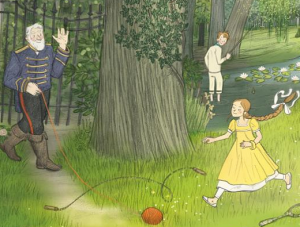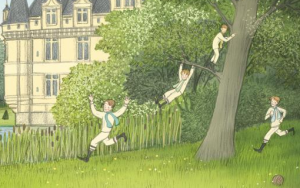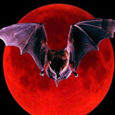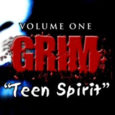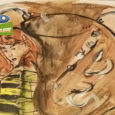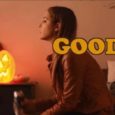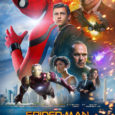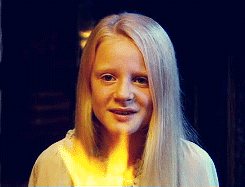I live…again!
After a longstanding battle with technical issues (one’s not quite solved, knock on wood) I’ve finally returned with another, this time just singular, but nevertheless amazing book to review from my perpetual favorite publisher, North South . This time it is for the illustrated adaptation of the Brothers Grimm fairy tale The Six Swans this time with freelance illustrator Gerda Raidt.
It is a beautiful tale, with a reading level from Kindergarten to 3rd grade, and deserves to be more well known amongst the Grimm’s broader repertoire. The premise resembles a lot of other tales; a king is father to six sons and one daughter all of whom he loves very much. He remarries and the jealous and spiteful stepmother, the daughter of a witch, enchants the six princes with a spell that turns them into swans. They fly off into the woods; now only able to turn human for a brief fifteen minutes each night. The princess finds them and vows to save her brothers from the spell, but to do so she is told she must sew six shirts from starflowers and not utter a word, or a laugh, anything for six long years. And so the princess begins her self imposed muteness and begins sewing them the starflower shirts. We then follow the girl as she’s found by a young king of another country in the midst of her hermitage.
North South always works with amazing illustrators on their books, Gerda’s work on this book is no exception. Sketchy and gently cartoonish, Gerda contributes a fresh and accessible look, very in vogue with current illustration trends that I particularly love. The characters are charming and jaunty with a mixed late 18th, 19th century and Edwardian era fashion and hair influences, and environments have a wonderfully pastoral aesthetic. Overall a treat for the eyes and easy for children to understand what’s going on. Even the endpapers are wonderfully designed and drawn on with starflower petals blowing in the wind.
A beautiful book to purchase as a gift for spring birthdays, finishing school or graduation gifts, or even for their Easter basket. For those who enjoy illustration and fairy tales at any age, it is a must read!
See you real soon!
Max Eber
Staff Writer/The Doctor
max@sub-cultured.com
Twitter: @maxlikescomics
I think it can be said that once Disney adapts a fairytale, the adaptation will eclipse the original story in the public’s consciousness. This rings especially true for their huge 1989 hit The Little Mermaid. Disney’s version is so influential that the name Ariel for many people under thirty no longer evokes the spirit in The Tempest but instead the dreamy red haired mermaid. Her iconic Glen Keane hair and green tail have influenced the depiction of mermaids, even in non-Disney merchandise, ever since.
The most disappointing result of this monopolization is that the Disney version, with its clear-cut villainy and happy ending, has in many ways diminished the awareness of the complexity found within the original story. In fact it has been posited that the story was written by Andersen as an expression of his pain for loving a young man which for many reasons was unrequited and could never be. It comes as a surprise to many people that the original tale has a considerably “bad end” for the Little Mermaid herself.
Luckily for those who want to become familiar with or are already fans of the original story there are a handful of both animated and film iterations, mostly from Russia in the 1950s to 70s. The Soviet studios of the time were very limited in what they could do; often the choice was between propaganda films or encouraged by the government adaptations of folk and fairytales and classic literature. Because of that choice, many of the most beautiful and true to source adaptations of fairy tales and novels like The Jungle Book and Andersen’s other masterpiece The Snow Queen come from animation studios like Soyuzmultfilm during that period.
Spinning out from that era is the 1976 live-action Czech film adaptation of “The Little Mermaid”, Malá morská víla. Directed by Karel Kachyna the film is a sensational but well-kept secret that should receive more attention not just as a faithful adaptation but also as a beautiful stand-alone film. Clocking in just under an hour and a half the film is sensitive, introspective and an utterly dreamlike piece that is unique amongst all iterations of the story in its balanced approach to saying faithful to the text and taking its own creative liberties (just like Disney did).
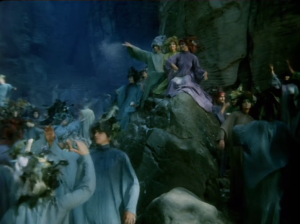
The first liberal and perhaps the most notable change is that the mermaids of Malá morská víla are presented as gossamer creatures, cloak-wearing water spirits, sans fish-tails (a point the Sea King in the movie openly mocks) of an unnatural pallor and elaborately twisted and sculptural hair decorated with found trinkets and seaweed. What’s more, these mermaids are not harmless. Their singing and the Sea King’s magic stones, much like the sirens and water spirits of lore, openly cause storms or hypnotize sailors and cause shipwrecks just for fun, after which they gleefully pillage for effects in a ceremonial fashion. There is a pronounced otherworldliness to their culture outside of the usual “I have fins and as such it is impossible to fraternize with humans” that has become standard in most modern tellings.
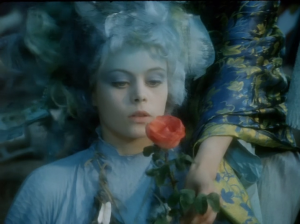
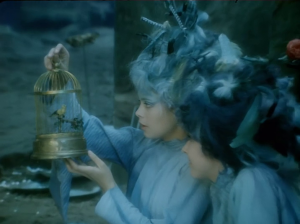
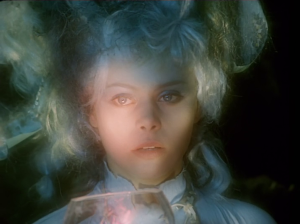
These choices makes all the difference. The world and culture of the mermaids, the Little Mermaid (played by the stunning Miroslava Safránková)’s year long curiosity about the human world after rescuing the Prince, and a subtextual storyline concerning her deceased mother, all take considerable emphasis over the actual romance of her and the Prince. In fact The Little Mermaid doesn’t transform and arrive on land until nearly sixty minutes into the film. Another element that is preserved from the original story is that the Sea Witch, while diabolical, is not vilified like the Disney version of Ursula. Unlike the original tale, the Sea Witch does not provide the Little Mermaid with a last minute solution to transform back into a mermaid should she fail to win the Prince’s heart. The dagger given to her to kill the Prince and his new wife and grant her the ability to return to the ocean is instead now attributed to the Sea King, which further removes the involvement of the Sea Witch from the story past her initial spell on the Little Mermaid. This choice is refreshing and adds additional complexity to the relationship between father and daughter.
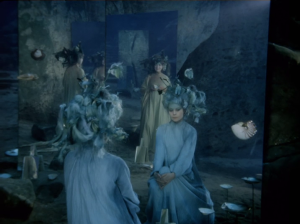
The costuming and make-up work paired with the dreamy and painstakingly arranged sets, lighting, choreography and notable music all together truly creates a convincing murky underwater world of blue and grey and white for the mermaid’s kingdom without any actual water; this Little Mermaid is hardly ever actually wet in this film. The human world above in contrast is a palette mainly full of red, whites, apricot-salmon pinks, browns and muted turquoise-blue that is present all the way down to the lead’s complexions and hair colors. All above the water is bathed in almost stark sunlight which continues the film’s gorgeous cinematography choices in the human world as much as they did when under albeit in a more subtle manner.
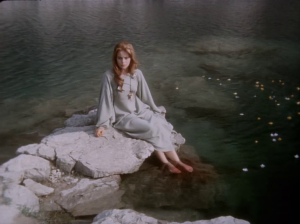

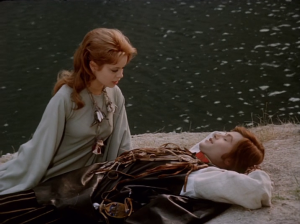
This film, despite its own unique changes to Andersen’s original, is the most sensitive and successful live action adaptation of the story that I have seen barring the Russian animated version from 1968 Rusalochka which is also worth watching for it’s stunning stylized animation. It both expands the character of The Little Mermaid and stays at the core a faithful and beautifully melancholic interpretation that celebrates the beauty of its own sadness. Although it is hard to find with English subtitles, it is worth seeking out in HD either on DVD (or torrent at Eutorrents shhh) or watch it subbed here. You can also watch the entire film without any subs here. For fans of fairy tales, fantasy films, and seventies art films, this movie is a gem and is one of if not my favorite fairy-tale adaptation on film, period. A must watch.
Please if you haven’t seen this film and do watch it, let me know what you think of this adaptation!
Max Eber
Staff Writer/The Doctor
max@ihogeek.com
Twitter: @maxlikescomics
So Jen and I are working on a joint paper and presentation for the ICFA (International Conference For The Fantastic In The Arts) coming up this March. We are exploring the similarities between Steven Moffat’s Doctor Who tenure as head writer and the relationship between the Eleventh Doctor and Amy Pond resembling that of Peter Pan and Wendy from Peter Pan. Amy is the ultimate audience avatar; the adult that got to “fly away to Neverland” with her childhood imaginary friend and subject of make-believe, and it is that key element of their relationship that we believe helped contribute to the show’s explosion of popularity globally, especially in America. We talk a lot about fairy tales and fantasy in our paper, specifically because Moffat’s writing style overall seems to be dabble in fairytale elements (Series 5 was explicitly intended to be a “dark fairytale”) where you’d normally expect original sci-fi conventions. Peter Pan is set in the designated genre of fantasy but is so inexplicably related to technology and progress (the assumed realm of sci-fi) due to it relying and have always relied on the advent of electricity (specifically for the portrayal of Tinkerbell). Steven Moffat is doing the opposite with Doctor Who, inverting that relationship. Moffat has been taking a purely sci-fi show and has been bending it into the realm of fairy tales and the mythological or mixes them to the point of being inseparable. His stories are intimate, there are no hanging out at space cantinas and much less emphasis on casual life or the world’s around them. Instead we are given very hyper-focused stories often cloaked with pagan and mythological elements with character driven stories essentially giving sci-fi a fantasy skin.
Moffat started the fantasy bending all the way back in ‘The Girl In The Fireplace’. Reinette is our first prototype Wendy in our paper, in that she, like Amy, meets the Doctor as a child. Reinette, however, like all of us inexplicably grows up and then never gets the chance to go fly away with The Doctor or “Peter” of her childhood, leaving her (like us) standing at the window.
It wasn’t until Series 5 with the introduction of Eleven that the Peter Pan parallelism Moffat introduces in ‘The Girl In The Fireplace’ came into full fruition with Moffat’s choices concerning Eleven’s new puckish, youthful but also extremely petulant personality and the introduction of Amy Pond who becomes the “Wendy” that gets a second chance even after growing up.
If people would like to follow Jen and I’s ruminations, progress with our paper and occasional shouting matches as we get closer and closer to the conference, you can follow our project blog here
Please enter the url to a YouTube video.
Here also for your viewing pleasure this weekend is a clip of the Darling children learning to fly and going off to Neverland from the 1924 silent adaptation of Peter Pan with Betty Bronson as Peter and Mary Brian as Wendy. It continued the pantomime tradition of Peter being played by a woman. Being made in 1924, only 20 years after first performance of Peter, the synergy of stage and the new(ish) rising potential of film and film effects just oozes from this clip through the use of the special effects. Yes, now crude by our standards, but check out that Tinkerbell at 4:08! That’s pretty darn cool isn’t it? Legend of Zelda anyone?


